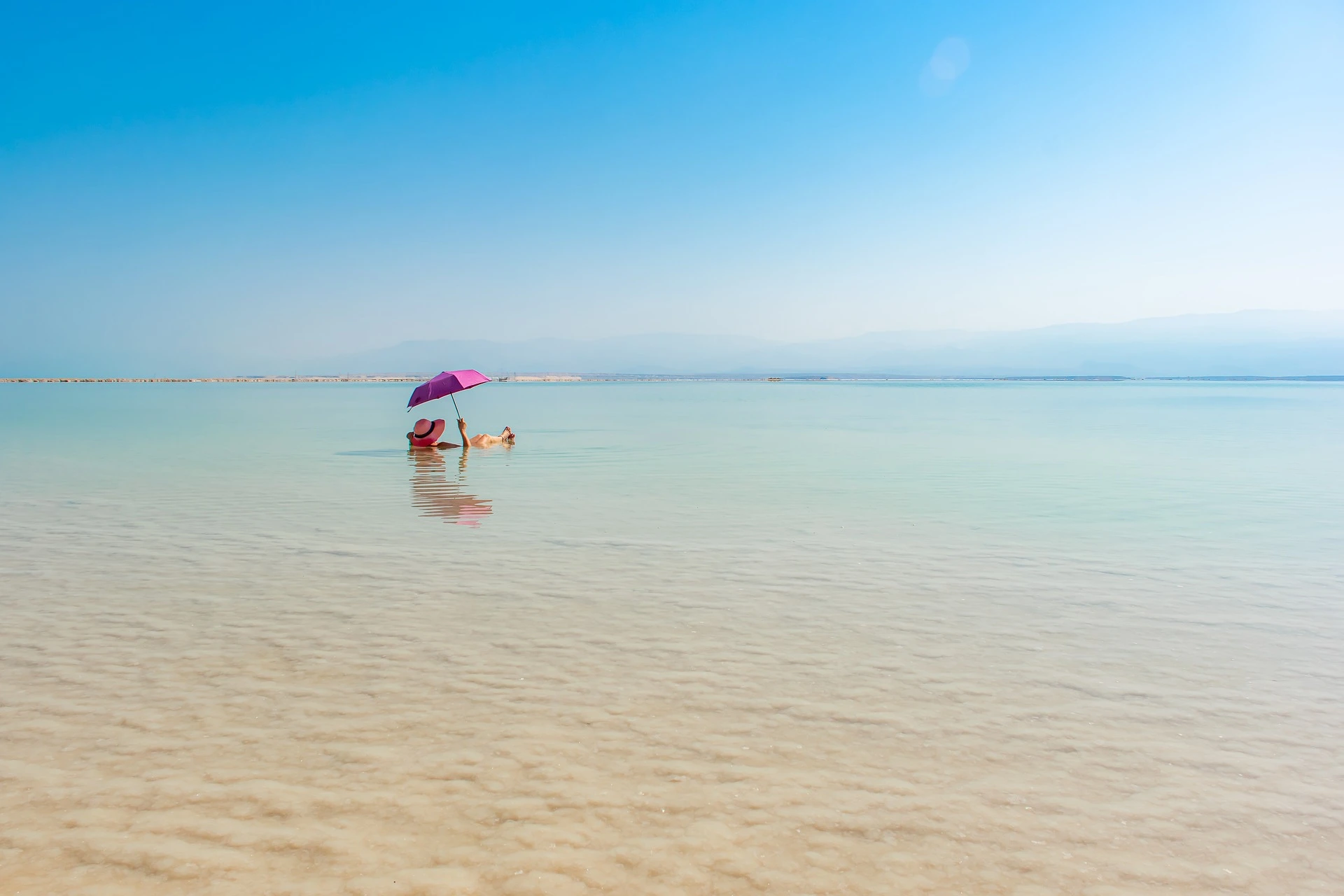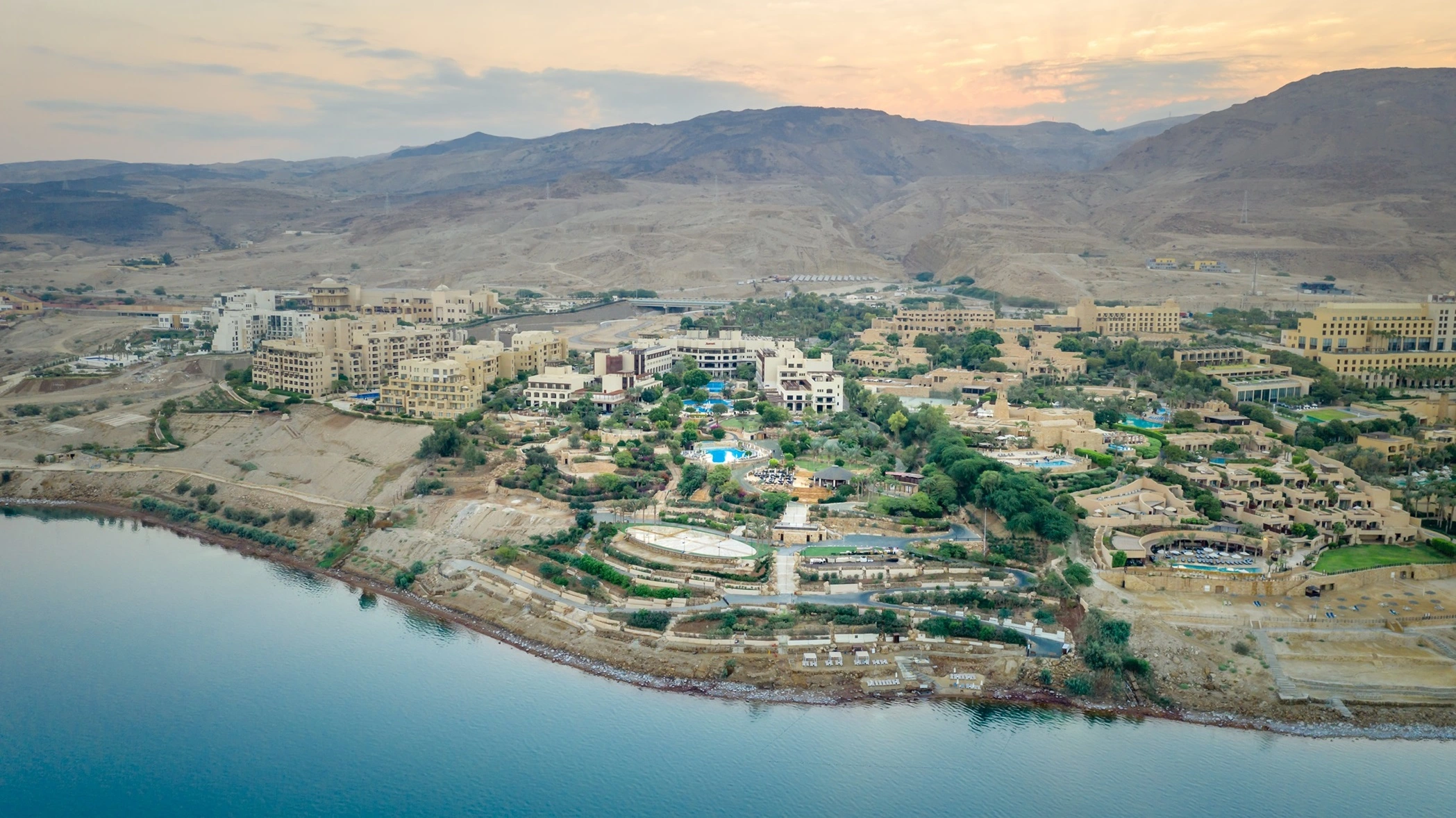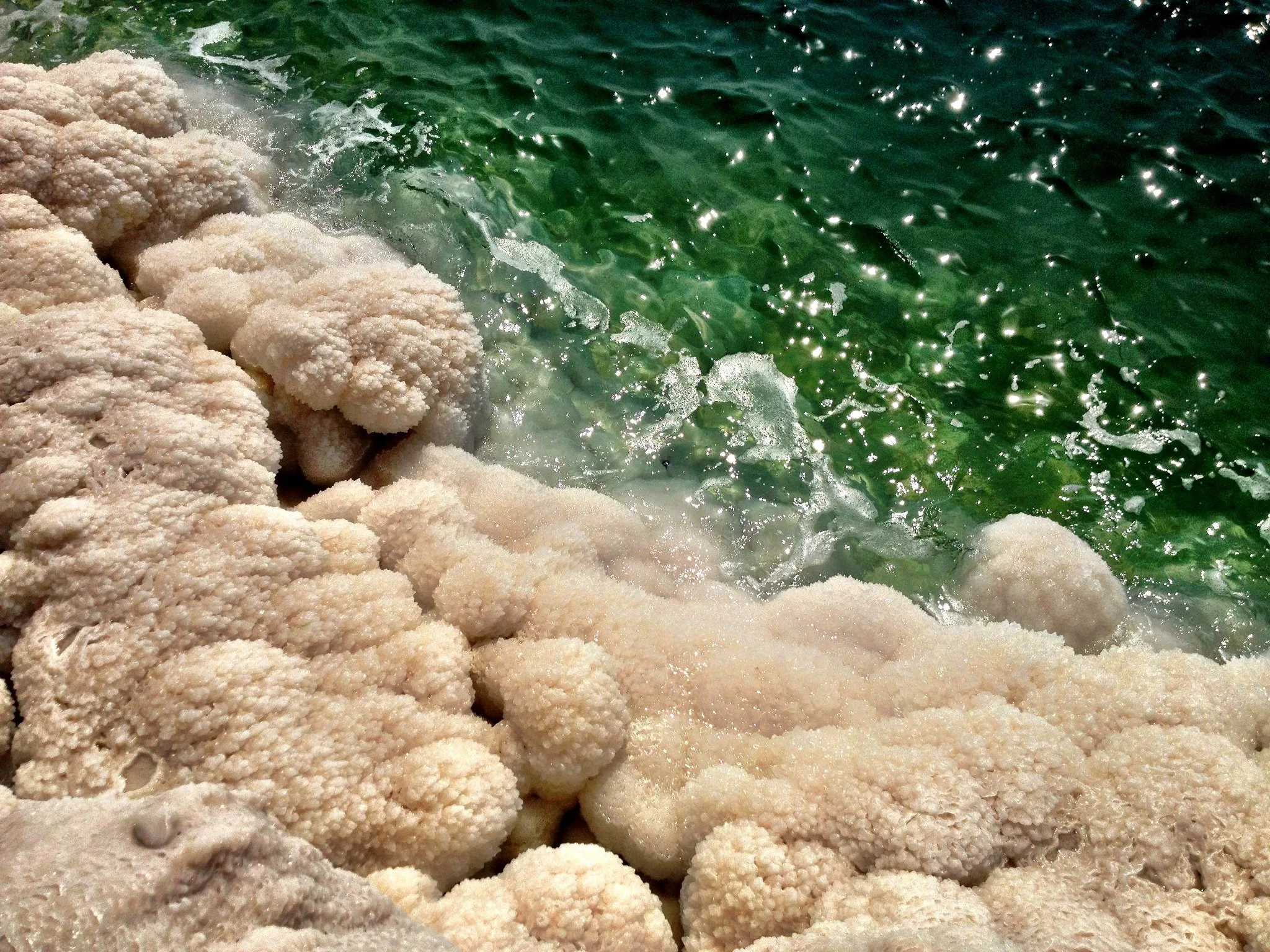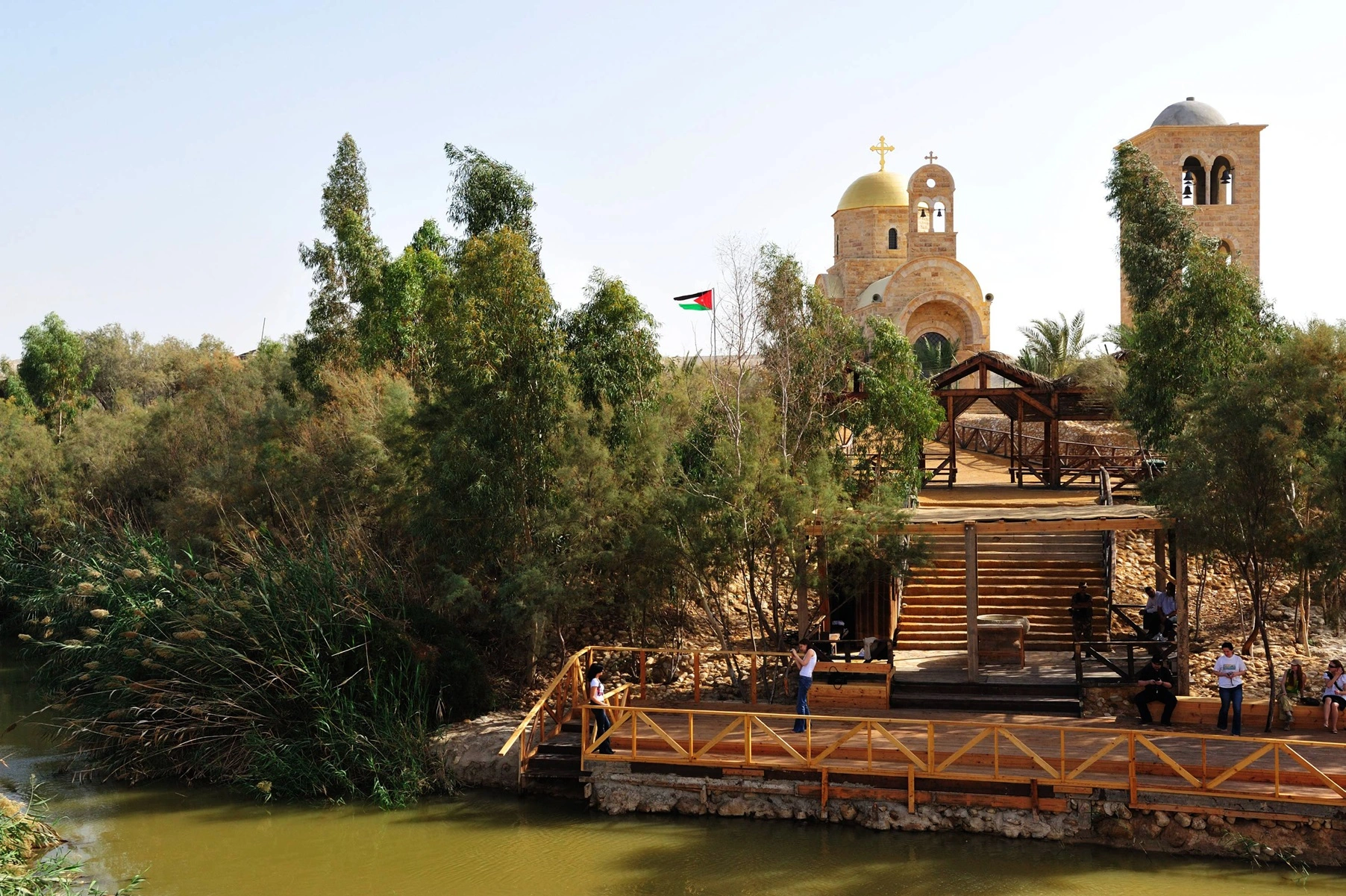When in Jordan, don’t miss a visit to the Dead Sea. This lake is landlocked between Jordan, Palestine and Israel and with 423 meters below sea level, the lowest point on earth. It is a perfect place to relax but can also serve as a base to visit religious attractions and water canyons in the vicinity. Here we list the most important information to prepare for your visit.
Where is the Dead Sea in Jordan?
The Dead Sea hotel area is less than an hour’s drive from Amman and a 3 hour’s drive from Petra. If you stay in Amman or Madaba you can visit the Dead Sea as a half day trip, combining it for example with a visit to Jerash or Madaba and Mt Nebo. The Dead Sea is about 50 km long and 15 km wide and lies in the Jordan Rift Valley. From the Jordan side, you can see across to the West Bank.
What is the best time to visit the Dead Sea?
The area around the Dead Sea is a barren landscape and has a desert climate. The most comfortable time of the year is a visit in spring (March to May) and in autumn (Sep to November). In summer the temperatures can climb up to 40 degrees Celsius and in winter can be about 20 degrees Celsius, which is considered by many visitors as too cool to float. Though, in winter the temperatures are milder at the Dead Sea than in Amman. So, in January and February the Dead Sea hotels might be a better base than Amman to tour Jordan. In spring and autumn, and especially during Eid holidays, it can get crowded at hotels and room prices are high.
Floating in the Dead Sea and Mud Pack at the Shore
Most people come to the Dead Sea to have a unique and fun experience by floating on waters. Due to the high salt concentration, the water has a high density so that one can float, but not swim. The water is rather warm and a little oily, rich in chloride salts of magnesium, sodium, potassium and bromine. At hotels and private beaches you can buy some famous mud to pamper your skin. The mud forms at the banks of the lake and is full of healing minerals. After a short exposure time, rinse off the mud in the sea or take a shower and be rewarded with softer skin.
What to pack and consider when visiting the Dead Sea
● As you want to float at the Dead Sea bring swimwear. Dark fabrics are recommended as the mud at the Dead Sea might cause stains.
● Flip flops or water sandals are essential. Due to the stony beach and salty rocks walking around barefoot can hurt your feet.
● Protect yourself from the sun by using sunblock.
● Any scrapes or cuts on your body will cause pains by the salty water. Avoid shaving one or two days before your floating experience.
● Don’t try to dive or splash at the Dead Sea; just float on your back. The salty water will cause great pain when reaching your eyes and nose.
● Keep your phone or camera away from the salty water.
● Float not longer than 10-15 minutes in the Dead Sea because the salt dries out your skin. After the bath, rinse off the salt under a shower to prevent skin irritation.
● Apply mud at the Dead Sea shore, let the mud dry first and soak again for 10 minutes and then rinse off in the showers.
● The sunset at the Dead Sea can be a colourful experience.
Overnight Stay versus Beach Use
You have the option to stay for the night at the Dead Sea, or just visit one of the beaches and continue to your next destination. Hotels on the Jordan side of the Dead Sea are concentrated in the area called Sweimeh. Basically, hotels are located more or less next to each other and there is no town around. You find here 5* hotel chains and local hotels with private beach. Many are offering spa treatments. Some vacation rentals are available as well but are not located at the beach. This means, for a floating experience you need to consider an entrance fee to a hotel or public beach.
Especially in high season, room rates are expensive. If you are on a budget or not interested in spending the night in a quiet place, you have the option of just a visit to a public beach or purchasing a beach use pass at one of the hotels. The entrance fee includes changing rooms, showers, pools and getting some mud.
Interesting Dead Sea Facts
● With an average salinity of more than 33 percent, the Dead Sea water is about 10 times saltier than regular seawater.
● The Dead Sea is a hub for medical tourism. The high concentration of minerals in the mud and the water, the higher oxygen content of the air and the reduced ultraviolet radiation have positive effects on dermatological and rheumatic diseases.
● As you guessed, the Dead Sea earned its name because plants and animals cannot survive in it.
● The Dead Sea is shrinking as the water level is dropping more than a meter per year. Main reason is that water from its tributaries does not reach the Dead Sea anymore and is diverted for irrigation.
Where can I see salt formations at the Dead Sea in Jordan?
Especially photographers are eager to see the patterns of salt formations at the shores of the Dead Sea. The formations contain sedimentary evaporite minerals, mainly rock salt, left by fast evaporation of the salty water. There are no salt formations at the hotel area in Jordan. They can be found along the Dead Sea road further south after the Wadi Mujib Reserve. You can search also on Google Map for “Coral Reefs” or “Wild Salt Shore”. You have to carefully climb down to the shore to get a closer look at the salt formations.
What to see around the Dead Sea in Jordan
The area around the Dead Sea offers natural and historical attractions. Several Biblical events took place here; and the Bible mentions the Dead Sea as Sea of Arabah, Salt Sea or Eastern Sea. If you made your base at the Dead Sea, day trips can be taken to the below sites.
● The Baptism Site is just a 20-minute drive from the hotel area in Sweimeh. Here Jesus was baptized by John the Baptist. Bethany beyond Jordan as it is also know, is one of the most important pilgrimage sites for Christians to Jordan.
● Driving south along the Dead Sea Road to Safi, you come to Lot’s Cave. It is believed, that after the destruction of Sodom and Gomorrah Lot and his daughters took refuge here. Remains of a Byzantine monastic complex can be seen here. Not far away is the Museum at the Lowest Point on Earth.
● Mount Nebo is believed to be the place where Prophet Moses died. From 700 meters above sea level enjoy panoramic vistas of the surrounding and visit early Christian mosaics and the remains of a 4th century monastery.
● Just a 10-minute drive from Mount Nebo lies the small town of Madaba. It is famous for its Umayyad and Byzantine mosaics at St George’s Church and the Archaeological Park. We recommend a visit to St John the Baptist Church as well as a simple stroll in the town’s centre.
● If you can’t get enough of history and Biblical events, make your way to Machaerus. Only a few remains of Herod’s Palace can be seen on the hilltop. But you will see the place where John the Baptist was imprisoned and later beheaded by Herod Antipas.
● Particular in winter it is a nice experience to take a bath at the hot springs at Hammamat Ma’in. Several natural mineral springs with different temperatures originate from rainfall in this area. There is a public pool or if you have no budget concerns buy a day pass from Ma’in Springs Resort.
● Within a short drive of 15-minutes you reach the Dead Sea Panoramic Complex. There is the small museum dedicated to the geology and ecology of the Dead Sea area, a short trail of 1.4 km called the Zara Cliff Walk, a panorama lookout over the Dead Sea and a local restaurant.
● Along the Dead Sea coast several wadis offer interesting hikes. We mention here only the popular and adventurous Wadi Mujib Siq Trail, accessible from April until October. If you do not want to pay an entrance fee or travel with children, the easy walk at Wadi Numeira is a recommendable option.




